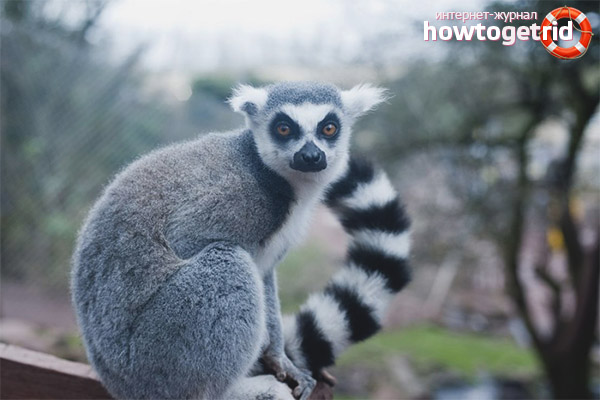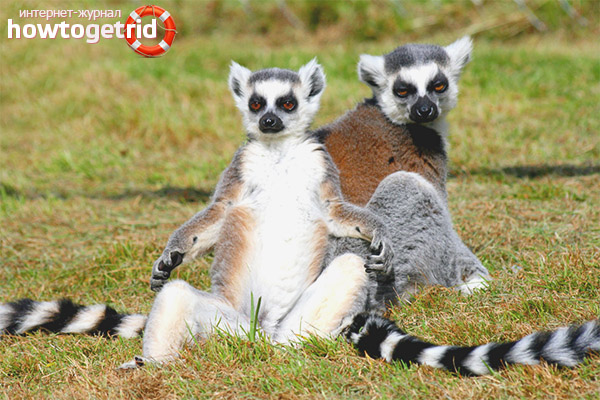The content of the article
Ring-tailed lemur is a primate from the lemur family, which lives only in Madagascar. He is also known by the names "Maki" and "Katta." These animals inhabit the entire island, up to the Andringitra Mountains. Scientists unite them in the suborder of wet-nosed, in which at the moment there are more than 100 species of lemurs. Moreover, over the past 20 years 70 new species have been assigned there because the criteria for their classification have changed.
Appearance
The cat lemur is not without reason that it has a name associated with pets, because in size it is comparable to a cat. The body length is 35-45 cm, and the tail length is 55-62 cm. Another sign related to this type of lemur with cats is the position of the tail: it is slightly twisted and very mobile. This decoration weighs 1.5 kg, which is more than a third of the total weight of the animal.
Such a long and heavy tail has several functions at once:
- Firstly, he allows lemurs to transmit signals to their relatives, twitching them.
- Secondly, feline lemurs with the help of their tail leave their own smell in the habitable territory.
- And thirdly, the tail provides balance while jumping and climbing tree branches. Despite all these advantages, lemurs cannot cling to them.
The color of the animals varies throughout the body. The coat on the back of the lemur is silvery or with a light pinkish-brown tint. Head and neck are dark gray. The paws of a cat lemur are grayish in color, but their inner surface is white. The muzzle is also white, around the eyes there are black spots in the shape of a triangle. A notable feature is 13 black and white stripes.
The animals have 5 developed fingers, with which they cleverly cling to tree branches and can hang in this position for some time. Lemurs make excellent use of the surrounding tree crowns for sleep and shelter from predators. The female can remain on the branches even with a baby clinging to her back.
Cat lemurs often become cartoon characters not only because of their appearance, but also because of their incredibly graceful gait. When moving, the lemur bends its back and lifts the tip of the tail up, having a rather arrogant and funny look.
Life among the congeners
Cat lemurs are jealous of their territories and place in the hierarchy, because of which fights often occur between them. During the "battles" animals grease the tail with a secret from under the arms, which has a sharp unpleasant odor. Waving such a smelly "weapon" in the face of an opponent, they prove their status.
Groups of feline lemurs do not make friendships with each other and often arrange skirmishes due to food or habitat. Moreover, often the case ends with several deaths.
Behavior
Cat lemurs spend their lives idly, and every day for them begins with sunbathing. The animals get out into the open and fall apart on their backs, exposing the abdomen to direct sunlight. It seems as if animals are immersed in meditation. After this procedure, the lemurs have breakfast, and then they brush and comb the hair for a long time.
Unlike their usual counterparts, cat lemurs prefer to spend time on the ground, and not among the crowns of trees. This is partly due to the aridity of the environment. In the evening the heat subsides, and lemurs have a peak of activity at this time.
Their location during the day depends on the quest for food. As a rule, lemurs travel no more than 1 km to get provisions. The skin on the palms of animals is very sensitive, which allows them to "see with their hands." In addition to this ability, males have sharp claws with which they scratch the bark of trees and comb out their hair. Lemurs not only clean their skin, but can offer this procedure to their relatives in exchange for a reward, for example, food or mating.
Food
The basis of the diet of cat lemur are fruits, plants, sometimes cacti and small insects. Fruit trees become the only source of food for animals in the rainy season. To store liquid during a drought, lemurs absorb aloe leaves. Sometimes they give themselves the trouble of hunting small birds and spiders.
In conditions of hunger or drought, when it is difficult to obtain food, cat lemurs do not disdain to nibble rotten stumps and tree trunks. If this situation persists for a long time, then the lemur hibernates for several days. At this time, his metabolism almost stops, which is why replenishment of the stomach to feline lemur is not required.
Breeding
In spring, feline lemurs begin the mating season, after which a pregnancy lasts 222 days. As a result, one cub is born in the female. The weight of the newborn is 110-120 g. In the first months of life, he cannot be separately from the mother and clings its paws to her coat. First, the baby hangs on his stomach, and later moves to his back.
The cub begins to leave the mother 1-2 months after birth. Despite the fact that most of the day the mother and child spend separately, they fall asleep and eat together. The female feeds a small lemur with milk up to 6 weeks of age, then the animal switches to solid food. The final weaning from mother’s milk occurs at 5 months, at the same time matured cat lemurs learn to live independently.
Life span
Due to the dry climate and the presence of natural enemies, half of the young die before they begin to live separately from their mother. Those who have overcome the trials of growing up live 20-25 years, in captivity this period can reach 30-35 years.
Home Content
Cat lemurs are one of those exotic animals that lend themselves perfectly to home breeding. But when you consider that the following requirements will be met:
- The space of the cage should be wide enough so that the animal can move freely and stretch the tail up.
- Feline lemurs, like humans, are prone to colds. Therefore, it is important to ensure that the cell is away from drafts and air conditioners.
- Feeding should occur in the dark due to the twilight lifestyle of feline lemurs. Cabbage, fruits, cucumbers, lettuce, cottage cheese, cereals from cereals without the addition of butter, bread and raw chicken eggs are suitable for the animal’s home nutrition. Sometimes the diet can be diluted with boiled chicken, mice, cockroaches and grasshoppers.
- It is impossible to accustom a lemur to a tray, therefore constant cleaning of premises is required.
- There should be clean, cool water every day in the drinker.
- Feline lemurs do not breed in captivity, and any acquired animal has already spent a certain part of its life in the wild. This leaves an imprint on the nature of the animals and makes them indescribable to training.
- An imitation of branches must be installed in the cage, as well as several toys scattered.
- Cat lemurs easily get along with people and do not show aggression towards them.
- From the first days of life, cat lemurs get used to the presence of their relatives, so you should keep them in two and not buy only one animal.
- If possible, an ultraviolet lamp with an average power should be installed above the cage. The ultraviolet rays stimulate the appetite of feline lemurs and increase activity.
- Cat lemur can not be released from the cage when the owner wants it. Animals that have just arrived in a new environment may experience stress and shock, which leads to unpredictability in their behavior. Putting such an animal back into the cage will be problematic. Therefore, in the first week, you should carefully monitor how the lemur reacts to people and pets, and only then provide him with the opportunity to move freely around the house.
Unusual facts about cat lemurs
- Ring-tailed lemur is able to make 12 types of sounds, and a special sound transmission system allows them to communicate at a distance of up to 2 km. They can purr, grunt, squeal, bark, and make clicking sounds.
- The population of cat lemurs, according to various estimates, does not exceed 50,000 individuals. Despite this, residents of the island of Madagascar have permission to freely shoot these animals.
- Feline lemurs are uncomfortable if fluid enters their coat, especially the muzzle. Therefore, while eating juicy fruits, they throw their head up so as not to get smeared.
- About 50 million years ago, there was a common ancestor of lemur and man.
- Ring-tailed lemurs sleep in heaps on tree branches, snuggling together to keep warm. It looks like one big live ball.
- The name "lemur" has Latin roots. This word means "spirit", "ghost." So called people whose souls did not fall for some reason into the underworld and remained wandering around the earth.
- Previously, lemurs lived in Africa, but over time they were crowded out by monkeys and humans.
- Lemurs are primates, whose appearance is most different from the human.
Video: Lemur catta













Submit